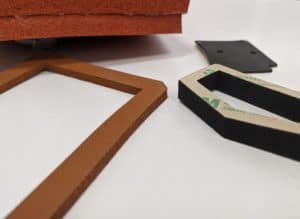
sponge gaskets
At NEDC, we commonly offer different gasketing solutions. Many in the industry organize cellular products in their head a few different ways. However, the specification ASTM D1056 organizes them by type, class, and then grade. Most of the materials characteristics can then be called out within three characters. This is just a summary of the specification, there are details of how to test, and what to test to located within the specification. Many other specifications either reference ASTM D1056 for its definitions and testing. It is largely seen as the authority on cellular products in the gasketing industry.
Type
There are two “types” 1 or 2. 1 indicates open-cell sponge, while 2 indicates closed-cell sponge. This indicates to the user how well the sponge material needs to be able to resist absorbing water. Type 2 must be less than a 5% absorption for densities over 10 pcf, and 10% for 10 pcf and less. Anything else is considered open cell sponge.
Class
A, B, C, D. These classes indicate different requirements of the material. This is probably where the variations really begin. For example, Class A indicates it is non-oil resistant. Many materials could meet this requirement. However, the other classes provide more stringent requirements.
Class A- Non-Oil Resistant
Class B- Fuel-Resistant, Low-Mass Change
Class C- Fuel Resistant, Medium-Mass Change
Class D- High-Temperature Resistance
Class A
As mentioned before, many different materials could meet Class A as that is a low-bar to clear. Oftentimes, sponge blends are found in this class as blending many properties of polymers can achieve a great product, but can have drawbacks when it comes to fuel-resistant requirements. Polymers such as SBR, Natural Rubber, and EPDM are commonly found in this class of materials.
Class B
Class B is the most stringent requirement for fuel resistance in the spec. This is typically where you will find epichlorohydrin(ECH), nitrile(buna-n), and other polymers that are very resistant to fuel.
Class C
Class C usually has a host of Neoprene Sponge materials in this class. Neoprene has great resistance to oil. Typically these are not blends, and if they are they contain a very high content of Neoprene Sponge.
Class D
Class D is high-temperature resistance. This is where you will find your high-temperature resistant polymers such as silicone sponge. Silicone sponge is the go-to in the industry for high-temperature resistance while featuring lower compression set.
Grade
This characteristic indicates the compression/deflection of the sponge material. The higher the number, the more force is required to compress it 25%. The available grades are 0-5. 0 indicates 0-2 psi, while 5 indicates 17-25 psi, with other grades in between 0 and 5. Different polymers are more challenging than others to achieve a specific density while meeting other requirements.
Additional Suffixes
Within ASTM D1056 there are other requirements that can be specified by suffixes. These suffixes are indicated by letters, A through W. Z indicates a special requirement that is not located in the specification.
Color
These materials come in a standard color of black unless otherwise specified. Most of the materials called out in the specification do come as a standard of black. However, silicone sponge is oftentimes provided in the standard rusty-red.
NEDC offers die-cutting, and waterjet cutting of cellular sponge products materials. For more information on ASTM D1056 or sponge gaskets, or you believe you have an application that could utilize them, please contact sales@nedc.com.